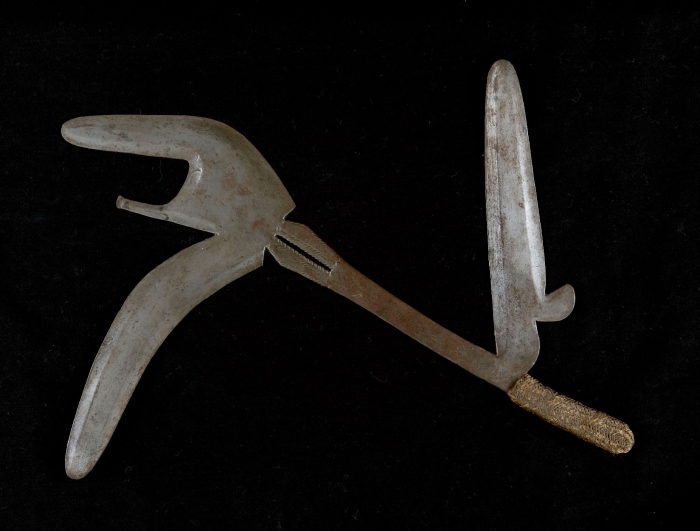Mambele on:
[Wikipedia]
[Google]
[Amazon]
A mambele is a form of hybrid knife/axe in central and southern Africa, originating from a curved throwing 
 The mambele consists of an
The mambele consists of an
Collection of mambeles
Belgium Edged and bladed weapons Throwing axes Axes African weapons Daggers {{DRCongo-stub
dagger
A dagger is a fighting knife with a very sharp point and usually one or two sharp edges, typically designed or capable of being used as a cutting or stabbing, thrusting weapon.State v. Martin, 633 S.W.2d 80 (Mo. 1982): This is the dictionary or ...
used by the Mangbetu.
Description
 The mambele consists of an
The mambele consists of an iron
Iron is a chemical element; it has symbol Fe () and atomic number 26. It is a metal that belongs to the first transition series and group 8 of the periodic table. It is, by mass, the most common element on Earth, forming much of Earth's o ...
blade with a curved back section and rearward spike. It can be used in close combat as a hatchet or dagger, or more typically as a throwing weapon. It usually consists of four blades, three on top and one on the side. The curved hook was used to keep the weapon in the victim, and if pulled out, caused further damage. It is about in length. These African iron weapons are thrown with a rotatory motion, and can inflict deep wounds with their projecting blades.
The mambele is also known as:
*Hunga Munga
*Danisco by the Marghi
Margi, also known as Marghi and Marghi Central, is a Chadic language (a Language family, branch of Afroasiatic languages, Afroasiatic) spoken in Nigeria, Cameroon, and Chad. It is perhaps the best described of the Biu–Mandara branch of that fami ...
*Goleyo by the Musgum
*Njiga by the Bagirmi
*Kpinga by the Zande. They were classed as "Court Metal", being produced under the patronage of the Avongara clan, distributed only to professional warriors, and considered status symbol
A status symbol is a visible, external symbol of one's social position, an indicator of Wealth, economic or social status. Many luxury goods are often considered status symbols. ''Status symbol'' is also a Sociology, sociological term – as part ...
s. It was also part of the dowry
A dowry is a payment such as land, property, money, livestock, or a commercial asset that is paid by the bride's (woman's) family to the groom (man) or his family at the time of marriage.
Dowry contrasts with the related concepts of bride price ...
that a man ought to pay to the bride's family. Soldiers would carry three or four into battle, hidden behind their shields. They were typically thrown at the enemy from away.
They vary constantly in form and their use extends across Africa, from the Upper Nile on the east through Central Africa and over to Gabon
Gabon ( ; ), officially the Gabonese Republic (), is a country on the Atlantic coast of Central Africa, on the equator, bordered by Equatorial Guinea to the northwest, Cameroon to the north, the Republic of the Congo to the east and south, and ...
in West Africa. The "musri" or "mouzeri" throwing knife of the Teda people
The Toubou or Tubu (from Old Tebu, meaning "rock people") are an ethnic group native to the Tibesti Mountains that inhabit the central Sahara in northern Chad, southern Libya, northeastern Niger, and northwestern Sudan. They live either as her ...
in the central Sahara
The Sahara (, ) is a desert spanning across North Africa. With an area of , it is the largest hot desert in the world and the list of deserts by area, third-largest desert overall, smaller only than the deserts of Antarctica and the northern Ar ...
is a variant. In parts of Central Africa these weapons assume the form of a bird's head.
These knives reflect the culture of Africa before Western colonisation
475px, Map of the year each country achieved List of sovereign states by date of formation, independence.
Colonization (British English: colonisation) is a process of establishing occupation of or control over foreign territories or peoples f ...
, both through their design and use. They can be symmetrical, bulbous, or even multi-pronged. Many are made of rarer and softer materials. These were harder to forge and were a status symbol to their owners.
See also
*Tomahawk
A tomahawk is a type of single-handed axe used by the many Native Americans in the United States, Indian peoples and nations of North America, traditionally resembles a hatchet with a straight shaft.
Etymology
The name comes from Powhatan langu ...
References
External links
* Poppe, Guido TCollection of mambeles
Belgium Edged and bladed weapons Throwing axes Axes African weapons Daggers {{DRCongo-stub